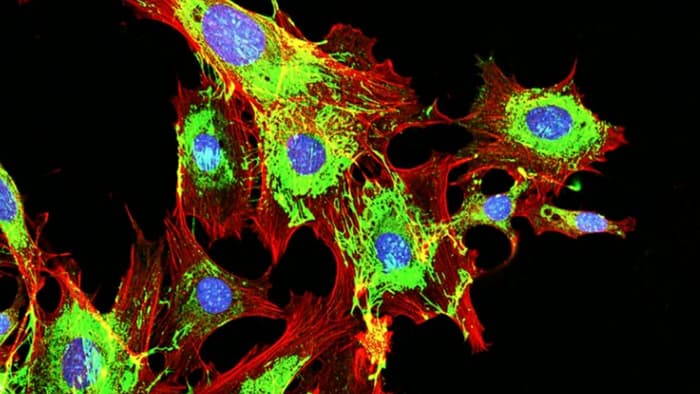Highlights
- •Tumor cells that survive impending death become stable pro-metastatic tumor cells, PAMEs
- •PAMEs display molecularly defined pro-metastatic states and form distant metastases
- •ER stress PERK-CHOP, GLI, and NANOG underlie the induction of PAMEs
- •A PAME cytokine storm induces PIMs from nearby tumor cells, which help PAMEs metastasize
Summary
How metastatic cells arise is unclear. Here, we search for the induction of recently characterized pro-metastatic states as a surrogate for the origin of metastasis. Since cell-death-inducing therapies can paradoxically promote metastasis, we ask if such treatments induce pro-metastatic states in human colon cancer cells. We find that post-near-death cells acquire pro-metastatic states (PAMEs) and form distant metastases in vivo. These PAME (“let’s go” in Greek) cells exhibit a multifactorial cytokine storm as well as signs of enhanced endoplasmic reticulum (ER) stress and nuclear reprogramming, requiring CXCL8, INSL4, IL32, PERK-CHOP, and NANOG. PAMEs induce neighboring tumor cells to become PAME-induced migratory cells (PIMs): highly migratory cells that re-enact the storm and enhance PAME migration. Metastases are thus proposed to originate from the induction of pro-metastatic states through intrinsic and extrinsic cues in a pro-metastatic tumoral ecosystem, driven by an impending cell-death experience involving ER stress modulation, metastatic reprogramming, and paracrine recruitment via a cytokine storm.
Introduction
Multiple mechanisms underlie the dissemination, homing, and distant seeding of metastatic cells, which cause the bulk of cancer-related deaths (Mehlen and Puisieux, 2006; Lambert et al., 2017; Wortzel et al., 2019; Lu and Kang, 2019; Hu et al., 2019; Follain et al., 2020; Massagué and Ganesh, 2021; Bertocchi et al., 2021). The origin of metastasis, however, remains obscure. Cells that give rise to metastases must first acquire pro-metastatic states inside the primary tumor before engaging the migratory machinery to eventually form secondary tumor masses elsewhere. We recently described a small cell group, the METSP, with pro-metastatic states in a heterogeneous, primary human colon cancer population using spiked-single-cell RNA sequencing (scRNA-seq) (Bernal et al., 2020). This and a previous study (Mishra et al., 2019) identified critical intra-tumoral cell interactions that modulate the acquisition of metastatic properties, consistent with the involvement of signaling and cell plasticity (Fidler and Kripke, 1977; Miller, 1983; Varnat et al., 2010; Singovski et al., 2016). However, how METSP states appear in the first place is unknown.Anti-cancer therapies with cell-death-inducing treatments (Longley et al., 2003; Comella et al., 2009; Carneiro and El-Deiry, 2020) can paradoxically enhance metastasis (Imamura et al., 1990; Wild-Bode et al., 2001; Poth et al., 2010; Vyas et al., 2014; Liu et al., 2015; Middleton et al., 2018; Karagiannis et al., 2019). How this comes about is not clear, although stemness acquisition, anastasis, senescence, and changes in the microenvironment have all been proposed to contribute (Tang et al., 2012, Tang et al., 2017; Ding et al., 2016; Tato-Costa et al., 2016; Sun et al., 2017, Sun et al., 2020; Xu et al., 2018; Middleton et al., 2018; Guillon et al., 2019; Berthenet et al., 2020). Cells surviving acute drug-induced apoptosis can display oncogenic traits including epithelial-to-mesenchymal transition (EMT), the modulation of epigenetic remodelers, and limited migration (Tang et al., 2012; Ichim et al., 2015; Tato-Costa et al., 2016; Sun et al., 2017; Seervi et al., 2019; Berthenet et al., 2020). However, as many of these studies selected cells from populations treated with apoptosis-inducing drugs at sub-lethal levels (Tang et al., 2012; Sun et al., 2017; Berthenet et al., 2020), it remained unclear if the used cells were actually fated to die, and thus it is unknown how phenotypes may match cell states.Survival from late apoptosis commonly triggered by the kinase inhibitor staurosporine (STS) (Wang et al., 2015a, Wang et al., 2015b; Xu et al., 2018) can be obtained through pharmacological inhibition of CASPASE activity with Q-VD-OPh and of mitochondrial outer-membrane permeabilization through the voltage-dependent anion channel blocker DIDS (Caserta et al., 2003; Liu et al., 2008). Cells obtained in this manner have been utilized to address regenerative processes. For instance, apoptosis-surviving myotubes dedifferentiate, reprogram to acquire progenitor cell properties, and participate in the regeneration of limbs and muscle (Wang et al., 2015a, Wang et al., 2015b; Bulatovic et al., 2015). Using this approach here, we ask if METSP states, which show enriched expression of the endogenous CASPASE inhibitors BIRC3 and XIAP (Bernal et al., 2020), can be induced in primary tumor cells that escape impending total population (apocalyptic) apoptotic death, thus representing an origin of metastases.
Results
PAME induction through rescue from impending death
Cell-lethal STS treatments followed by their blockade 6 h later with the apoptotic inhibitors Q-VD-OPh plus DIDS (BLOCK) (Wang et al., 2015a, Wang et al., 2015b; Figures 1A and 1B ) were performed on heterogeneous colon cancer CC14 cells (Varnat et al., 2009). Cells only treated with DMSO or BLOCK (control) were unaffected (Figures 1B and S1C), whereas 100% of the cells treated with STS died with apoptotic phenotypes (Figures 1B, 1C, S1A, and S1B), providing a clean background. Rescued PAMEs, obtained by STS + BLOCK with recovery of 10% after 5 days, proliferated and incorporated 5-ethynyl-2′-deoxyuridine (EdU) (Figures 1C, S1C, and S1D).







